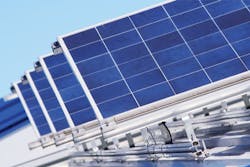Herb Graham Jr., owner of Herb’s Body Shop in Marion, Ohio, didn’t think of his shop as a candidate for going green. But when he heard what kind of money the government was offering in exchange for installing renewable energy sources—solar panels, in his case—he changed his tune.
Right now, there are a slew of generous grants and kickbacks available for small businesses that adopt environmentally friendly technology, essentially subsidizing expenditures that save owners money. It’s a classic win-win situation: Collision repair shops achieve compliance, save money on energy, and attract customers who want to patronize earth-friendly businesses. And the best part? The government will pay you to do it.
Graham’s shop is an example of these financial incentives in action. In exchange for installing 210 solar panels on the roof of his body shop—a $293,000 project—Graham will get $146,000 back from the state, and another $88,000 from the federal government. And it gets better: The panels will produce 47,035 kilowatt hours of power each year, saving $7,500 in electricity costs at current rates, or 40 percent of the shop’s electrical needs. In addition, Graham will make 28 cents apiece from each kilowatt of solar power generated by selling its Solar Renewable Energy Credits (SRECs). (Electric companies use SREC purchases to bypass state laws requiring a portion of their electricity be generated by renewable energy sources.) That’s a nice yearly bonus of $13,169.80.
Such subsidies aren’t limited to solar power. All sorts of green initiatives qualify for government rebates, tax credits and other financial incentives, says Steven Schillinger, of GRC-Pirk, an independent auditing firm in Reno, Nev. “Because of the public awareness of green, everybody wants to get on board,” he says. Schillinger points to one of the key provisions of the Energy Policy Act of 2005, a tax deduction of up to $1.80 per square foot for certain environmental improvements made for equipment put into service since 2005. For more programs like this, the Environmental Protection Agency’s website (epa.gov) is a good place to begin.
Alan Frasz, vice president of Dovetail Solar and Wind, the company that installed Graham’s solar panels, recommends checking out the Database of State Incentives for Renewables & Efficiency (website at dsireusa.org), which is sponsored by the U.S. Department of Energy. “It lists every state in the union, and has what kind of programs are out there,” he says.
Although Graham says he’s happy to help the planet, he admits the green that motivated him most was cash. “Would I have done this without incentives? No, I wouldn’t have,” he says. But with the rebates, installing the panels was just good business sense, he says. “Shops always talk about diversifying to create new profit centers. Well, this is actually better than doing something like installing truck bed liners,” he says. “I just put this stuff on my roof and I make thousands of dollars a year on it.”
